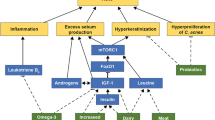Abstract
In view of findings from previous studies that a chitin soluble extract (CSE) blocked adhesion of Candida albicans in vitro and in vivo and prevented thereby a short lived candidal infection in naive mice, we attempted in the present study to block by CSE the development of a persistent infection, induced in hormone-treated animals. Continuous oestrus phase was obtained in mice by repeated weekly subcutaneous injections with estradiol benzoate. Intravaginal inoculation of the hormone-treated mice with 107–1010 C. albicans cells induced a persistent candidal infection. Fifty three mice were pretreated intravaginally prior to inoculation of C, albicans with 2.5, 5.0 or 10 mg/mouse of a CSE cream and followed up for development of infection in comparison to 30 untreated animals. Twenty four hrs post fungus inoculation the infection rate among the CSE treated mice was 11–23% VS 84% among the controls; the rate increased a week later to 97% among the controls VS 41–50% among the CSE treated. Administering the CSE to the mice prior — and post-yeast inoculation (37 mice), led to increased efficacy of the treatment. The data, indicating that CSE is an effective measure for preventing persistent candidal vaginitis, may open the way to consider a similar approach for prophylaxis of vaginitis in human susceptible populations.
Similar content being viewed by others
References
Fleury FJ. Adult vaginitis. Clin Obstet Gynecol 1981; 24:407–438.
Odds FC. Candidosis of the genitalia. In: Candida and Candidosis. Baltimore: University Park Press, 1979; 100–112.
Sobel JD. Epidemiology and pathogenesis of recurrent vulvovaginal candidiasis. Amer J Obstet Gynecol 1985; 152:924–935.
Ryley JF. Pathogenicity of Candida albicans with particular reference to the vagina. J Med Vet Mycol 1986; 24:5–22.
Lehrer N, Segal E, Barr-Nea L. In vitro and in vivo adherence of Candida albicans to mucosal surfaces. Ann Microbiol 1983; 134B:296–306.
Segal E, Soroka A, Lehrer N. Attachment of Candida to mammalian tissues — clinical and experimental studies. Zbl Bakt Hyg 1984; A257:257–265.
Segal E, Lehrer N, Ofek I. Adherence of Candida albicans to human vaginal epithelial cells: inhibition by amino sugars. Expl Cell Biol 1982; 50:13–17.
Ryback B. The Oestrus cycle. In: Principles of zoophysiology. Oxford: Pergamon Press, 1968; 519–526.
Spanel-Borowski K, Wildfeuer A, Meister H, Haferkamp O. Experimental Candida vaginitis in the mouse. Arch Gynak 1976; 221:313–322.
Taschdjian CL, Reiss F, Kozinn PJ. Experimental vaginal candidiasis in mice; its implications for superficial candidiasis in humans. J Inv Dermatol 1980; 34:89–94.
Kinsman OS, Collard AE. Hormonal factors in vaginal candidiasis in rats. Infect Immun 1986; 53:498–504.
Ryley JF, McGregor S. Quantification of vaginal Candida albicans infections in rodents. J Med Vet Mycol. 1986; 24:455–460.
Sobel JD, Muller G, McCormick JF. Experimental chronic vaginal candidosis in rats. J Med Vet Mycol 1985; 23:199–206.
Author information
Authors and Affiliations
Rights and permissions
About this article
Cite this article
Segal, E., Gottfried, L. & Lehrer, N. Candidal vaginitis in hormone-treated mice: Prevention by a chitin extract. Mycopathologia 102, 157–163 (1988). https://doi.org/10.1007/BF00437398
Accepted:
Issue Date:
DOI: https://doi.org/10.1007/BF00437398




